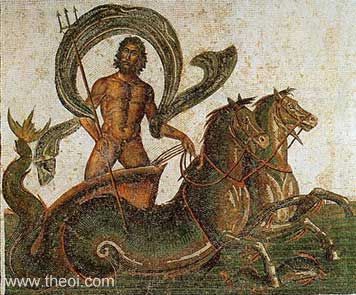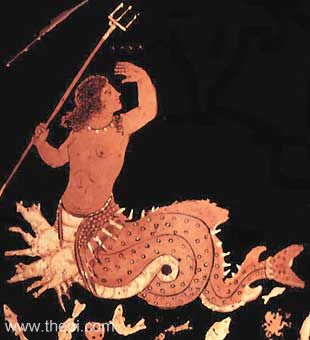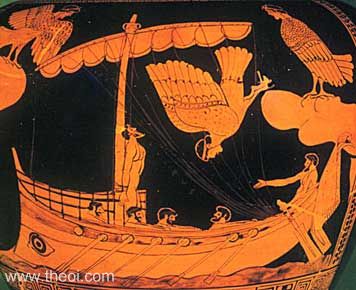Do you remember when I had that terrible dream about being chaced through the woods by some horrible creature? I quite liked doing that post, but becase the setting was clearly on land, I had to leave out some of the terrifying aquatic mythological creatures that Hellenic mythology boasts. Today, I wanted to rectify not having a source list of sea or lake based creatures from Hellenic mythology on my blog.
Drakaena
The Drakaena were hybrids, usually with the upper body of a beautiful nymph, and the lower body of a drakon or sea-monster. Famous examples include the Goddess Keto, who spawned the Hesperian Drakon, Ekhidna, who was married to the serpent-giant Typhôeus and spawned most of the dragons and monsters of myth, and Skilla (see below).
 Hippokampoi
Hippokampoi
The Hippokampoi were not exactly monsters, btu they make the list because of the idea the ancient Hellenes had about them. Hippokampoi were the horses of the sea. They were depicted as composite creatures with the head and fore-parts of a horse and the tail of a fish. They were often covered with green scales and had fish-fin manes and appendages. The ancients believed they were the adult-form of the fish we call the 'sea-horse'. They were the mounts of Nereid nymphs and sea-gods, and Poseidon drove a chariot drawn by two or four of the beasts.
 Karkinos
Karkinos
Karkinos (Καρκινος) was often pictured as a giant crab or crustacean. He features heavily in the mythology of Hēraklēs. On the hero's second labor, slaying the Lernaean Hydra, Hera send Karkinos to distract Hēraklēs while he fought. Unfortunately for the animal, Hēraklēs wasn't very impressed. He either kicked the animal so hard, that Karkinos flew so far into the sky, he can hardly be seen, or he squashed the crab, and Hera placed him into the sky for trying. She did, however, dim his stars because he had failed at his task. Needless to say, Karkinos is the constellation Cancer.
Ketea
The Ketea are sea-monsters who--like most Drakones resembled snakes. They were destroyers, usually sent by the Gods in punishment. According to the ancient Hellenes, the Ketea had real-life counterparts as well, in the deep Indian oceans, and in the form of the Scolopendra. Kētos (below) was a Ketea.
Kētos
Kētos was the name of the sea monster sent by Poseidon as a favor to the sea God Nereus, who was insulted by the queen of Ethiopia, Cassiopeia, who boasted that either her daughter, or she, or both were equal or even greater in beauty than Nereus' children, the Nereids. Nereus would only be appeased when Cepheus sacrificed his daughter to Cetus. Cepheus had refused, but when the terror continued, Androméda had offered herself up to be sacrificed. Kētos was petrefied by Perseus with Médousa's severed head.
Kharybdis
The ancient hellenes in the time the Odysseia was written seem to have been largely unaware that the rise and fall of sea levels are caused by the combined effects of the gravitational forces exerted by the Moon and the Sun and the rotation of the Earth. Instead, they held a single entity responsible: a monster or a Goddess controlling a whirlpool. If your ship got stuck in the pull of the whirlpool, youw ere as good as dead.
Skylla
During Odysseus' travels to get home, he must run his ship through a narrow passage. One the one side are rocks with a cavern. In this cavern, Skylla, sea monster with six heads, lived, and she would take one of Odysseus' men with each of her heads. On the other side lay Kharybdis, a great whirlpool which would suck in any ship that came too close. It is up to Odysseus to choose one or the other. Eventually, he chooses Skylla, and looses many brave men, his ship, however, is in tact.
Sirens
The Sirens (or Seirenes) were three sea nymphs who lured sailors to their death with a bewitching song. They were formerly handmaidens of the goddess Persephone, and were always depicted as birds with either the heads, or the entire upper bodies, of women. In modern tales, they are generally seen as mermaids--part huma woman, part fish, but the ancient Hellenes disagreed.
Drakaena
The Drakaena were hybrids, usually with the upper body of a beautiful nymph, and the lower body of a drakon or sea-monster. Famous examples include the Goddess Keto, who spawned the Hesperian Drakon, Ekhidna, who was married to the serpent-giant Typhôeus and spawned most of the dragons and monsters of myth, and Skilla (see below).
 Hippokampoi
HippokampoiThe Hippokampoi were not exactly monsters, btu they make the list because of the idea the ancient Hellenes had about them. Hippokampoi were the horses of the sea. They were depicted as composite creatures with the head and fore-parts of a horse and the tail of a fish. They were often covered with green scales and had fish-fin manes and appendages. The ancients believed they were the adult-form of the fish we call the 'sea-horse'. They were the mounts of Nereid nymphs and sea-gods, and Poseidon drove a chariot drawn by two or four of the beasts.
 Karkinos
KarkinosKarkinos (Καρκινος) was often pictured as a giant crab or crustacean. He features heavily in the mythology of Hēraklēs. On the hero's second labor, slaying the Lernaean Hydra, Hera send Karkinos to distract Hēraklēs while he fought. Unfortunately for the animal, Hēraklēs wasn't very impressed. He either kicked the animal so hard, that Karkinos flew so far into the sky, he can hardly be seen, or he squashed the crab, and Hera placed him into the sky for trying. She did, however, dim his stars because he had failed at his task. Needless to say, Karkinos is the constellation Cancer.
Ketea
The Ketea are sea-monsters who--like most Drakones resembled snakes. They were destroyers, usually sent by the Gods in punishment. According to the ancient Hellenes, the Ketea had real-life counterparts as well, in the deep Indian oceans, and in the form of the Scolopendra. Kētos (below) was a Ketea.
Kētos
Kētos was the name of the sea monster sent by Poseidon as a favor to the sea God Nereus, who was insulted by the queen of Ethiopia, Cassiopeia, who boasted that either her daughter, or she, or both were equal or even greater in beauty than Nereus' children, the Nereids. Nereus would only be appeased when Cepheus sacrificed his daughter to Cetus. Cepheus had refused, but when the terror continued, Androméda had offered herself up to be sacrificed. Kētos was petrefied by Perseus with Médousa's severed head.
Kharybdis
The ancient hellenes in the time the Odysseia was written seem to have been largely unaware that the rise and fall of sea levels are caused by the combined effects of the gravitational forces exerted by the Moon and the Sun and the rotation of the Earth. Instead, they held a single entity responsible: a monster or a Goddess controlling a whirlpool. If your ship got stuck in the pull of the whirlpool, youw ere as good as dead.
Skylla
During Odysseus' travels to get home, he must run his ship through a narrow passage. One the one side are rocks with a cavern. In this cavern, Skylla, sea monster with six heads, lived, and she would take one of Odysseus' men with each of her heads. On the other side lay Kharybdis, a great whirlpool which would suck in any ship that came too close. It is up to Odysseus to choose one or the other. Eventually, he chooses Skylla, and looses many brave men, his ship, however, is in tact.
Sirens
The Sirens (or Seirenes) were three sea nymphs who lured sailors to their death with a bewitching song. They were formerly handmaidens of the goddess Persephone, and were always depicted as birds with either the heads, or the entire upper bodies, of women. In modern tales, they are generally seen as mermaids--part huma woman, part fish, but the ancient Hellenes disagreed.



No comments:
Post a Comment